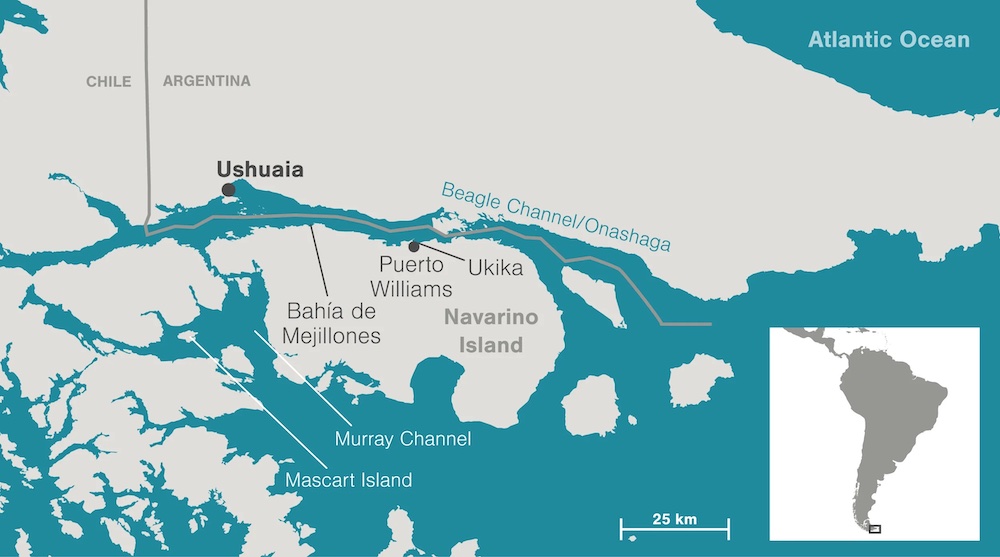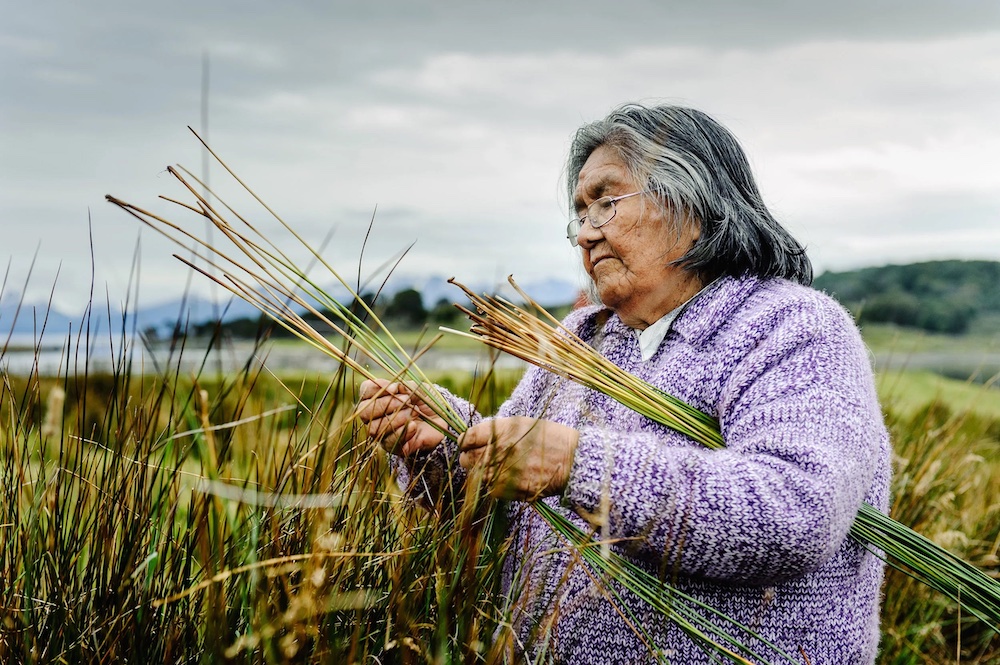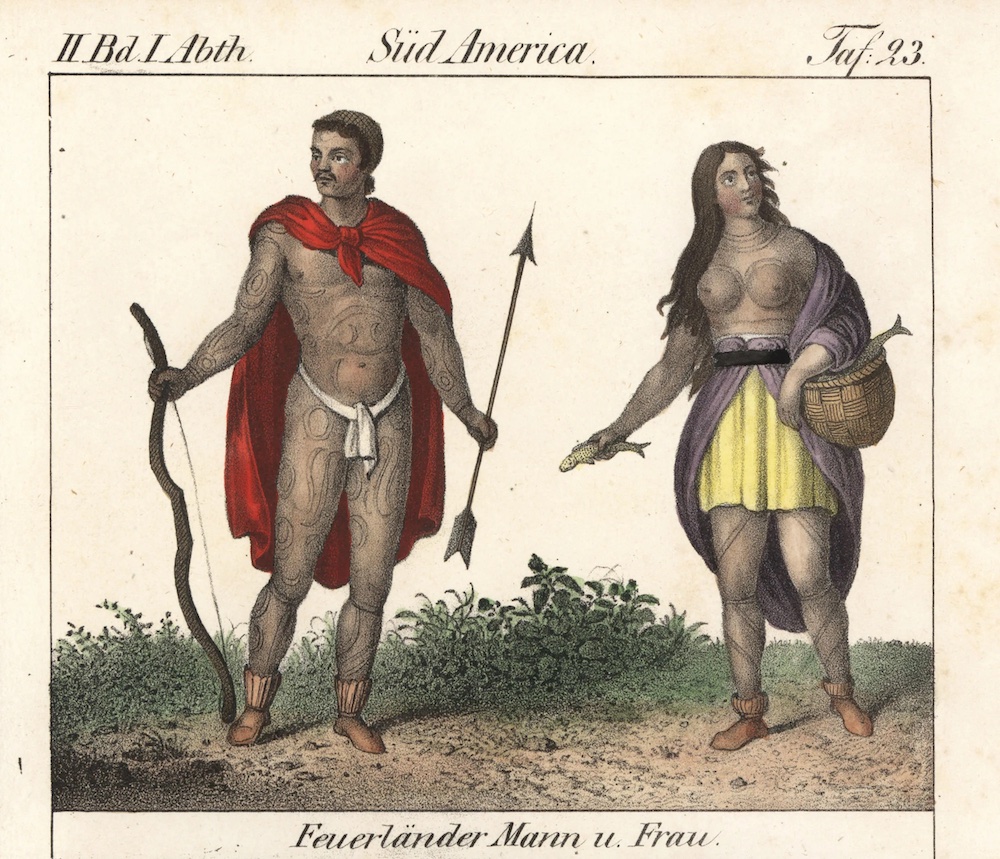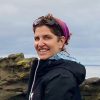The Yaghan Rise Again
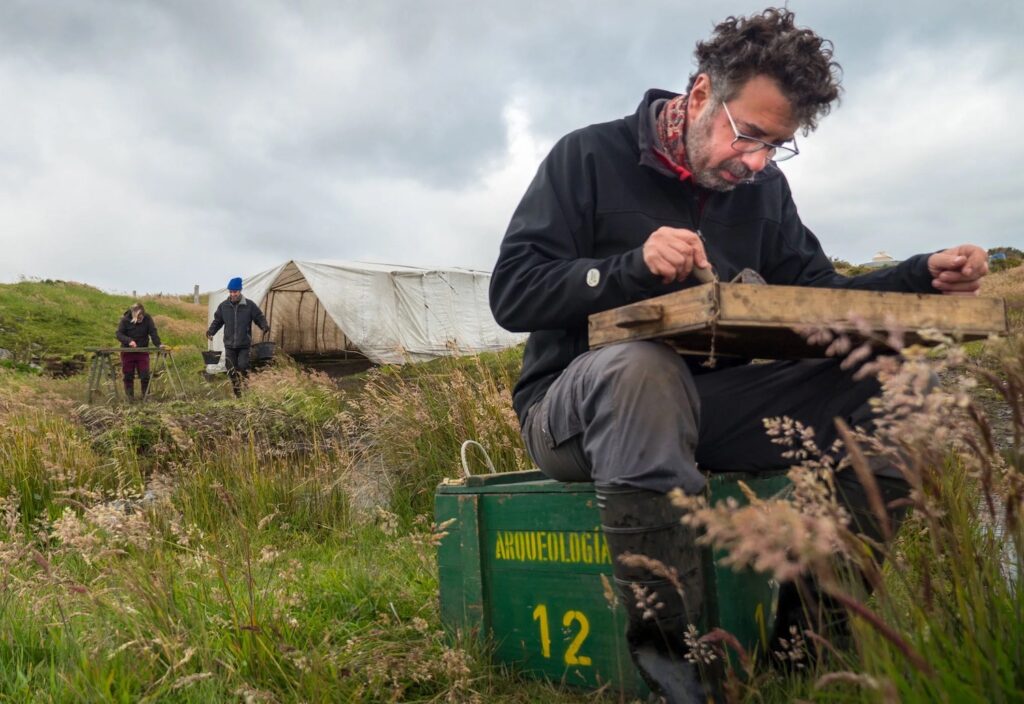
This article was originally published in Hakai Magazine and has been republished with permission.
This is the end of the world: el fin del mundo, as the tourist brochures dub it; Tierra del Fuego, as it is known more universally; and home, as the Indigenous Yaghan people have called it for much of the past 8,000 years and probably longer.
The southernmost tip of South America is a jagged splay of islands, as if a careless god dropped a dinner plate. The Atlantic and Pacific oceans meet here, and the match is pitilessly stormy. The weather is mercurial—rain, hail, snow, and sun can beat the land within the span of an hour—but, on this summer’s day in February, it is sunny, warm, and windless. Kelp gulls natter, waves lap against a rocky islet, and a coppery tang—a blend of marine snails and algae—wafts across the reef where I’m helping gather limpets, scraping them off rough stones along the Beagle Channel.
Bucket full, I head off in José German González Calderón’s rowboat, in search of his crab pots. I am on the starboard oar, photographer Kat Pyne is on the port, and González Calderón watches our flailing from his seat at the stern with an expression that flits between willed neutrality and bemusement. Feofeo, his fluffy white dog, sits in the prow. Feofeo, Spanish for “uglyugly,” is cutecute and staring at us.
González Calderón, 58, solidly built, with a full head of gray-dusted hair, teases us: “Feofeo is bored; we are going too slowly.”
Everyone’s a critic.
González Calderón was, until recently, not supposed to exist—because he is Yaghan. Like the Palawa in Tasmania, the Sinixt in Canada, and the Karankawa in the United States, the Yaghan have the dubious distinction of coming back from the dead, their extinction declared by outsiders—Europeans and their descendants—for over a century.
Despite thousands and thousands of years of history, the story of the Yaghan, and other Indigenous cultures, has often emphasized one moment: the disastrous meeting with Europeans. And that’s what drives me here, an irritation that across the Americas, popular culture has focused relentlessly on that one point in time, and though significant, it’s like writing a badly abridged version of a multilayered story. A deeper truth lies buried, rich with a diversity of characters spanning time and place.
For the past few decades, archaeologists have been digging past the narrative told by European adventurers and chroniclers, those who killed some Yaghan, stole some, converted some to Christianity, and declared them all gone. They are searching the landscape more broadly than previous excavators, reinterpreting decades’ worth of data, and opening their minds to the evidence before them. They are unearthing in greater and greater detail a counternarrative centered on the longevity and tenacity of the Yaghan—on how they went about making Tierra del Fuego, now split between Argentina and Chile, their home as the millennia spooled past. Joined with the oral histories of a proud and increasingly assertive Yaghan community, the archaeology aids in a people’s resurrection.
The story lies in the present too. González Calderón has invited us to spend a couple of days with him on Navarino Island, a part of Yaghan territory, which once stretched across parts of Tierra del Fuego, practically to the tip of South America. The island, part of Chile today, has been Yaghan territory for thousands of years, and it’s where most of the Indigenous community still lives.
Still high in the sky, the sun shimmers off the water as we land the rowboat at Bahía de Mejillones, Bay of Mussels. The bay looms large in Yaghan history. Shell middens—heaps of mostly mussel and limpet shells—dot the beach, extending meters deep. Standing vigil is the home of the bay’s last full-time Yaghan inhabitant, Benito Sarmiento, who, in the 1960s, resisted when the Chilean government moved the community and others of the archipelago to the outskirts of the island’s only sizable town: Puerto Williams, population 2,000, an hour’s drive east. Today a few Yaghan keep cabins in Bahía de Mejillones, but they only visit. Sarmiento lived alone in the cove until his death in the 1970s. Sarmiento’s home, they say, serves as a reminder that the people will return.
González Calderón’s one-room yellow cabin perches on a hill above the road. The Argentine city of Ushuaia, across the Beagle Channel—called Onashaga by the Yaghan—seems like an easy canoe ride away, and we joke about paddling to the Irish pub there for a beer. The only drama comes from the mainland mountains in the distance, the jagged tail of the Andes, high enough to mistake for the ramparts of heaven. A light that evokes something divine reflects off ice saddled between the ridgeline’s stony spires.
We chat and gaze across the channel. González Calderón scrapes the limpets from their shells, chops seaweed, and adds some vegetables packed for the trip into a pot to make soup. It has a lovely saltiness that only the ocean can impart, and every once in a spoonful, a little smiley face, a limpet, peers up in seeming disbelief through strands of seaweed.
González Calderón’s mother, Úrsula Ercira Calderón Harban, was born in Bahía de Mejillones in 1923, and he spent his early years on nearby Mascart, a small island across from a bay where the Yaghan massacred missionaries in the 19th century. Úrsula died in 2003. Her sister Cristina Calderón Harban remained as the matriarch of the community on Navarino Island until she died, age 93, this past February. She lived surrounded by family in Villa Ukika, the Yaghan village skirting Puerto Williams. Cristina wove baskets, told stories, and kept the Yaghan language alive.
As we sit and sip soup, a friend of González Calderón’s, Jaime Ojeda, a Chilean marine ecologist, tells me that Cristina was sick of journalists. Ojeda has known the Calderón family since 2008, when he lived on Navarino Island, researching seaweed and mollusks for his master’s thesis. He arranged this trip to Bahía de Mejillones. Cristina, Ojeda says, had to endure endless requests for interviews and ersatz stories of her fashioned by outsiders: the last speaker of a language, the last to remember a dead way of life, the last of the “true” Yaghan. This broken “last of” narrative sticks like gum to a shoe, embedded in the sole. Even tourists sought out Cristina, hoping for a last-chance-to-see moment they could post on social media.
The Yaghan past is present everywhere on Navarino Island, in the shell middens, in the bounty of the ocean, in the animals and mountains that feature in stories, in a carefully curated museum, and in the people themselves. But in today’s currency of words and pictures, the tourists seemed to want to capture Cristina as an embodiment of an ancient people. They wanted her to validate the stories that Eurocentric voyeurs spun of exaggeration, assumption, insularity, and willful ignorance. It’s a faulty narrative that began in 1519.
Ferdinand Magellan sails from Spain in that year, across the Atlantic and through a strait at the tip of South America into the Pacific, the first European to do so. When he reaches the southern tip of South America, smoke blankets the shoreline. Magellan names it the Land of Smoke, Tierra del Humo. He sails on. The king of Spain, however, declares that where there is smoke there is fire, and renames the land the catchier Tierra del Fuego. The name—encapsulating a brief moment, a scene misunderstood and little contemplated—sticks.
Almost 60 years later, after weeks bashing around the Southern Ocean, storm-tossed sailors of the Golden Hind, captained by English privateer Francis Drake, spot a bay. People materialize out of the bush. A priest onboard scribbles notes about canoes filled with men and women paddling from island to island, children wrapped in skins hanging on their mothers’ backs. The canoes are marvelous, he writes.
And so begins the journaling or, in anthropology-speak, the ethnography. Written mostly by White male Europeans in English, French, Italian, German, Dutch, and Spanish, the number of words spilled on the Yaghan is astounding. The Europeans are by turns admiring and dismissive, but mostly they’re obtuse.
The Dutch arrive as early as 1616. In February 1624, eager to engage in battle against the Spanish Armada in Peru—apparently a necessary step toward world domination—they park their fleet in various bays of islands south of Navarino Island. In one, where five ships anchor, sailors row to shore in search of water and firewood. After they fail to return, their compatriots find five corpses and two survivors on the beach. Another 12 sailors are missing. The Yaghan have dispatched them with spears and bows and arrows. The Europeans label the Yaghan cannibals, a calumny that will dog them for 250 years.
The decades tick by, with visits from Englishman Captain James Cook in 1769 and 1774. He calls the region’s people “a little, ugly, half-starved beardless Race,” sprinkles their territory with the name Desolation—as in Cape and Island—yet gushes about the rich marine life, particularly whales and seals. Soon after, the first whaling boat sails around Cape Horn into the Pacific Ocean and sperm whale territory. Legendary tangles with that species—perhaps the most difficult whale to capture—become the inspiration for Moby-Dick. Whale oil fuels the Industrial Revolution. Exploration fuels exploitation.
The Europeans steal people, bring them back to Europe, display them or try to civilize them, then return them home. On his first voyage to Tierra del Fuego in the late 1820s, Captain Robert FitzRoy penetrates Onashaga, the channel at the heart of Yaghan territory, in his brig-sloop, the Beagle: The Beagle Channel will thereafter carry that naval vessel’s name. FitzRoy absconds with four people—Fuegians, he called them—and brings them to England. One dies.
The written record becomes the narrative, limited and blinkered by the lens of a vastly different culture.
On his second voyage, in 1831, FitzRoy returns with the three surviving Fuegians and a young Charles Darwin, who approves of the manners the trio have gained living as the English do—in boarding schools. Their English names are Jemmy Button, Fuegia Basket, and York Minster. Their names are Orundellico, Yokcushlu, and Elleparu. The Yaghan Darwin meets on Navarino Island, in contrast, revolt him. The man whose keen observations and open mind launch a scientific revolution writes, “They are such thieves & so bold Cannibals that one naturally prefers separate quarters.” Darwin is not fine hobnobbing with his Fuegian shipmates’ relatives. He thinks they eat their grandmothers.
Europeans are Energizer bunnies, nothing deters them: not months spent on cramped wooden sailing ships, not treacherous seas, not bad weather, bad food, or risk of death. They keep coming. As in zombie movies, the plot never changes, only the actors. European explorers come and go—the way dream monsters do—and their impermanence makes them manageable. Next up? Missionaries in search of heathens. Cue the low note of doom, an ominous hint that life, for the Yaghan, will now change dramatically. God can throw anyone’s universe into chaos.
Until now, the Yaghan are masters of their fate. Fires keep them warm—on land and in their bark canoes—and so probably does the sea mammal fat smeared on their skin. They paint their bodies with red ochre, black charcoal, and white clay. Clothes—seal-skin capes, loincloths—are minimal. The land gifts them tall, straight trees, southern beech that they strip of bark to craft canoes. The ocean offers endless bounty: sea urchins, mussels, limpets, cormorants, penguins, fur seals, sea lions. Sometimes the sea bestows more than any one tribe can wish for—a whale beaches itself, an opportunity broadcast through smoke signals to neighbors. Kindness and generosity are virtues. Uplifting oral histories guide the living with takeaways like “courage conquers all” and “the impossible is made possible.” Spirituality embraces the nonhuman world: to mock animals and water spirits is dangerous. And as we all might be, the Yaghan are suspicious of hairy men living without women.
But by the mid-19th century, a Christian organization in England, having heard the Yaghan are docile and untarnished by popish priests, raises funds to send a mission to convert them. Saving souls is a competitive Christian practice. An early mission, composed of seven men, starves to death, though not before killing a few Yaghan. Later, on Navarino Island, the Yaghan massacre an all-male mission. Subsequent efforts to convert the people succeed, especially when the missionary Thomas Bridges, who became fluent in the language, takes over and brings his wife to Yaghan territory on what will become the Argentinian side of the Beagle Channel.
With the mission comes the Argentine navy, a declaration of Argentine sovereignty, and the measles. In 1888, the Bridges family witnesses an epidemic that nearly wipes out the Yaghan. In a memoir, Uttermost Part of the Earth, Thomas’ son Lucas writes: “They were a dying race, who seemed to know it.”
Once ringing, there’s no stopping the death knell.
Martin Gusinde, an Austrian priest and ethnologist, visits four times between 1918 and 1924. He establishes relationships with the people, particularly Nelly Calderón Lawrence, an ancestor of González Calderón, and dives into the culture—the Yaghan museum on Navarino Island bears his name—describing rituals and mythology in danger of being extinguished along with the language. Gusinde estimates a population of roughly 70, and he, too, falls into the notion that the people will soon cease to be.
In 1934, a former U.S. ambassador to Chile announces the Yaghan “all but vanished.” In 1977, in a bestselling book, In Patagonia, English writer Bruce Chatwin declares he has met the last Yaghan, Grandpa Felipe. In 1986, a Chilean journalist publishes a book about a Yaghan elder, Rosa Yagan: The Last Link.
The written record, centuries deep, becomes the narrative, limited and blinkered by the lens of a vastly different culture. There is a different story. Or, more precisely, stories.
This article continues on, sharing how archaeology has played a key role in the movement toward Yaghan cultural revival and recognition: Read the full article here.

































